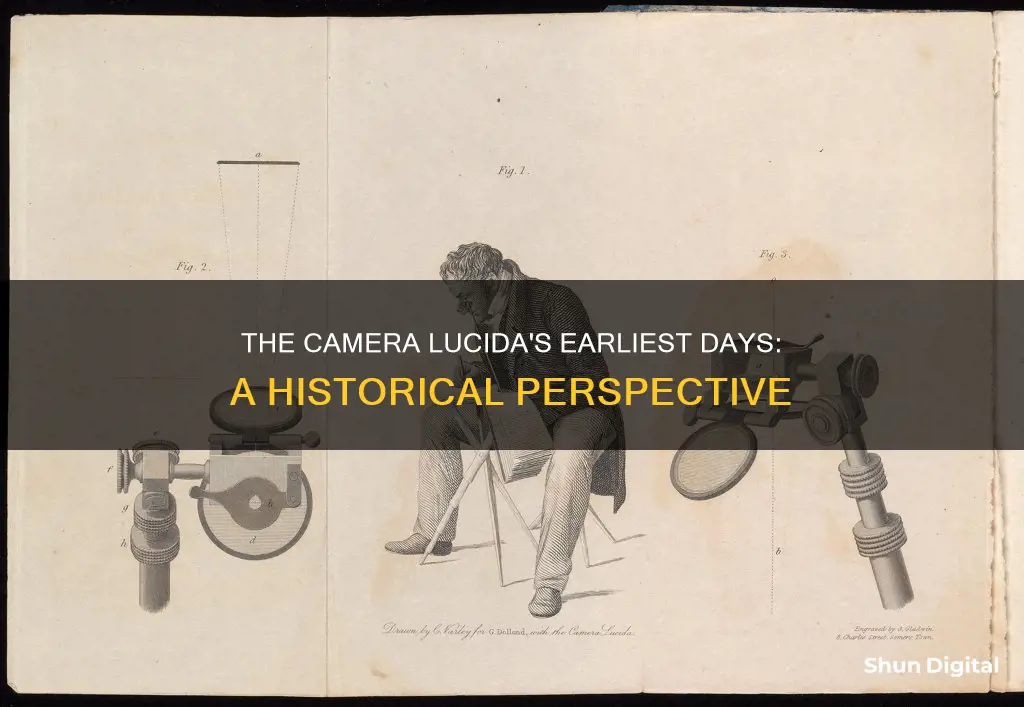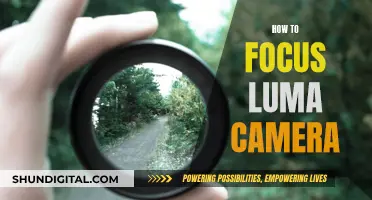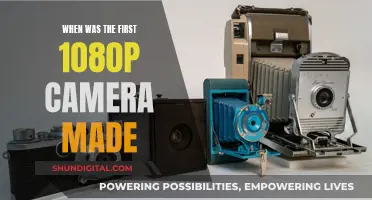
The camera lucida is an optical device used as a drawing aid by artists and microscopists. It was patented in 1806 or 1807 by English chemist and physician Sir William Hyde Wollaston. The device consists of a four-sided prism mounted on a small stand above a sheet of paper. By looking through the prism, the user can see a reflected image of what's in front of them, allowing them to trace the image onto the paper. The camera lucida was widely used in the 19th century and played a pivotal role in the history of imaging, as it inspired the development of photography.
| Characteristics | Values |
|---|---|
| Year Invented | 1806 or 1807 |
| Inventor | Sir William Hyde Wollaston |
| Other Inventors | Professor Peter Barlow (1730), Horace-Bénédict de Saussure (1799) |
| Invention | Patented the Camera Lucida |
What You'll Learn

The camera lucida was patented in 1806 or 1807
The camera lucida is an optical device used as a drawing aid by artists and microscopists. It was patented by English chemist and physician Sir William Hyde Wollaston in 1806 or 1807. Wollaston's device was simple: a prism on an adjustable stand. When an artist looks down through the prism, they see the world in front of them, as well as their hand on the page, combined in perfect superimposition. This allows the artist to trace what they see in full daylight, making the camera lucida portable and easy to use.
The basic optics of the camera lucida were described by German astronomer Johannes Kepler in his 1611 work, *Dioptrice*. However, there is no evidence that he constructed a working camera lucida. The term "camera lucida" (Latin for "light chamber" or "well-lit room") was coined by Wollaston, in contrast to the "camera obscura" or "dark chamber/room". Wollaston's design used a prism with four optical faces to produce two successive reflections, resulting in an image that is not inverted or reversed. The camera lucida was more portable than the camera obscura, and artists could work in direct sunlight without the need for a darkened room.
The camera lucida was widely used in the mid-1800s, and it is believed that many of the most admired drawings of the 19th century, such as the Neoclassical portraits of Jean-Auguste-Dominique Ingres, were created using this device. The camera lucida played a pivotal role in the history of imaging, inspiring the development of photography. For example, William Henry Fox Talbot, a close friend of famed English astronomer Sir John Herschel, was disappointed with his attempts at drawing using the camera lucida and sought to chemically fix images to paper, leading to the invention of photography in 1835.
The Pros and Cons of Deleting Raw Camera Files
You may want to see also

It was invented by Sir William Hyde Wollaston
The camera lucida was invented by Sir William Hyde Wollaston, an English chemist and physicist. Wollaston was born in 1766 in Norfolk and studied medicine at Cambridge University, obtaining his doctorate in 1793. In addition to his work in medicine and chemistry, he had a keen interest in optics and conducted research in this field, making important discoveries such as the dark gaps in the solar spectrum in 1802.
Wollaston's invention of the camera lucida in 1806 or 1807 revolutionised life-drawing for artists. The device was simple: a prism on an adjustable stand. When an artist looks down through the prism, they see both the world in front of them and their hand on the page, perfectly superimposed. This allowed artists to easily trace what they saw, in full daylight, without the need for a dark enclosure as with a camera obscura.
Wollaston's design used a prism with four optical faces to produce two successive reflections, resulting in an image that was not inverted or reversed. The camera lucida was portable and easy to use, and by the mid-19th century, it had become widely popular. It is believed that many of the most admired drawings of the 19th century, such as the Neoclassical portraits of Jean-Auguste-Dominique Ingres, were created using this device.
In addition to his work on the camera lucida, Wollaston also developed the first lens specifically for camera use, called the meniscus lens, in 1812. He improved image projection by changing the shape of the lens, reducing distortion. Wollaston's contributions to the fields of chemistry, physics, and optics have left a lasting impact, and he is remembered as a pioneering scientist and inventor.
Troubleshooting Camera Raw: Autocropped Images Explained
You may want to see also

It's a simple optical device
The camera lucida is an optical device used as a drawing aid by artists and microscopists. It is a simple, lightweight, and portable device that does not require special lighting conditions. In its simplest form, it consists of a glass pane or half-silvered mirror tilted at 45 degrees, through which the artist looks down at the drawing surface. This superimposes a direct view of the drawing surface and a reflected view of the scene in front of the artist, allowing the artist to trace the subject with accuracy.
The camera lucida was invented in 1806 or 1807 by the English chemist or physician William Hyde Wollaston. Wollaston's design used a prism with four optical faces to produce two successive reflections, thus creating an image that is not inverted or reversed. The prism was carefully shaped and oriented so that the rays of light from the scene were reflected twice within the prism before reaching the eye. This results in the eye seeing the image the right way up, as opposed to the inverted image produced by the camera obscura.
The camera lucida was a significant advancement in the quest for automated drawing, which stretched back to the Renaissance. It was more portable than the camera obscura, and its ability to be used in direct sunlight made it a popular tool for artists. By the mid-19th century, camera lucidas were widespread, and it is believed that many of the most admired drawings of the 19th century, such as the Neoclassical portraits of Jean-Auguste-Dominique Ingres, were created using this device.
The basic optics of the camera lucida were described by the German astronomer Johannes Kepler in his 1611 work "Dioptrice", but there is no evidence that he constructed a working model. The term "camera lucida" (Latin for "light chamber" or "well-lit room") was coined by Wollaston to distinguish it from the camera obscura ("dark chamber" or "dark room").
Converting Camera Raw Files to JPEGs: A Step-by-Step Guide
You may want to see also

It's lightweight and portable
The camera lucida is a lightweight, portable device. It was designed to be lightweight and portable, and it is this feature that sets it apart from its predecessor, the camera obscura. The camera obscura requires a darkened room, whereas the camera lucida can be used in full daylight.
The camera lucida was invented by Sir William Hyde Wollaston in 1806 or 1807. It is an optical device used as a drawing aid by artists and microscopists. It allows the user to trace what they see, superimposing it onto a drawing surface. The device consists of a prism on an adjustable stand. The prism reflects the image from its base onto tracing paper at right angles to its face. The user looks down through the prism and sees the world in front of them, as well as their hand on the page, allowing them to copy what they see onto the page.
The camera lucida is lightweight and portable due to its simple design. In its simplest form, it consists of just a prism and a stand. The prism is made of glass or crystal and has four sides. One side is at a right angle, two sides are at a 67.5-degree angle, and one side is at a 135-degree angle. This carefully designed shape allows the prism to reflect the image without inverting or reversing it. The stand is adjustable so that the user can position the prism at the correct height and distance from the drawing surface.
The camera lucida's portability was a significant advantage over the camera obscura, which was larger and more cumbersome. The camera lucida could be easily carried and used in a variety of settings, making it a versatile tool for artists and scientists. Its lightweight and portable design also contributed to its widespread use in the 19th century. By the mid-1800s, camera lucidas were everywhere, and many famous artists are believed to have used them, including Jean-Auguste-Dominique Ingres and William Henry Fox Talbot.
Zumimall Camera Charging Time: How Long Should You Wait?
You may want to see also

It's still used in certain fields today
The camera lucida was patented in 1806 by English chemist and physician Sir William Hyde Wollaston. It is an optical device used as a drawing aid, allowing artists to trace what they see.
It is still used in certain fields today. As recently as the 1980s, the camera lucida was a standard tool for microscopists. It is still used in palaeontology, as well as in biological taxonomy and neuroscience. In these fields, it is used to draw brain and microanatomical structures. It is recognised to have limitations, particularly around distortion, and new digital methods are being introduced to limit or remove this.
The camera lucida is still available through art-supply channels but is not well-known or widely used. It has seen a resurgence through Kickstarter campaigns and modern apps that use augmented reality to help artists with their perspective and drawing.
Camera Battery Lifespan: How Long Does It Last?
You may want to see also
Frequently asked questions
The first camera lucida was made in 1806 by Sir William Hyde Wollaston.
The camera lucida was invented by Sir William Hyde Wollaston, an English chemist and physician.
A camera lucida is an optical device used as a drawing aid by artists and microscopists. It projects an optical superimposition of the subject being viewed onto the surface the artist is drawing on, allowing the artist to duplicate key points of the scene.
The artist looks down through a prism, seeing the world in front of them and their hand on the page, combined in perfect superimposition. The artist can then trace what they see in full daylight.







